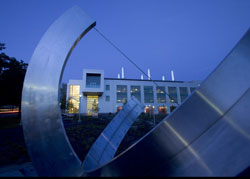"I would found an institution where any person can find instruction in any study." - Ezra Cornell

Cornell has been described as the first truly American university, on account of its founders' revolutionary egalitarian and practical vision of higher education. It was established in 1865 by Ezra Cornell, farmer, mechanic and educational pioneer, and Andrew Dickson White, who served as the University’s first president.
Since then, Cornell has built up a reputation as one of the leading universities in the U.S., a member of the Ivy League, an elite group of universities renowned for their academic excellence, and a pioneer of higher education in areas as diverse as veterinary science and journalism.
Cornell now has seven undergraduate units and four graduate and professional units in Ithaca, and two medical graduate and professional units in New York City. Student enrolment in 2006-07 was over 20,000. The distinguished faculty, more than 2,700-strong, includes recipients of the Nobel Prize, the Pulitzer Prize and the National Academy of Science Award for Initiatives in Research, among many other awards.

The university was ranked first in National Science Foundation funding for programs in academic science and engineering in 2003-04.* Two years later, Cornell’s total research expenditure topped $605 million.
A growing network of links with institutions across the globe includes joint study and exchange programs with China, India and Singapore; Cornell administered programs in Europe and Japan; the Arecibo Observatory in Puerto Rico; and biodiversity field stations in the Dominican Republic and Peru. By establishing WCM-Q in 2001, Cornell broke new ground, becoming the first American university to offer its M.D. degree overseas.
(*The latest year for which figures are available)
Overview of Cornell University, Ithaca - Arabic
www.cornell.edu